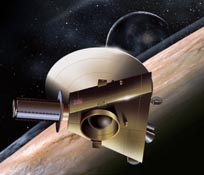
With luck the New Horizons spacecraft will be skimming past distant, enigmatic Pluto (foreground) and its moon, Charon, 15 years from now. The spacecraft will feature four instruments, a plutonium-fueled powerplant, and a radio dish 2.5 meters (8 feet) across.
Courtesy JHU/Applied Physics Laboratory and Dan Durda.
In the coming months Congress will decide the fate of the New Horizons Pluto-Kuiper Belt mission. Earlier this week the House and Senate Appropriations Committees went against NASA Administrator Sean O'Keefe's wishes and moved to fund the mission with $105 million for the 2003 fiscal year. New Horizons would be part of NASA's recently introduced "New Frontiers" program, which allocates up to $650 million for spacecraft designed to study solar system objects. Current plans call for a single craft to be launched in 2006, fly by Pluto and Charon as early as 2015, and pass a Kuiper Belt object by 2026. Pluto is the only major planet not yet visited by spacecraft.
Project scientist Andrew Cheng (John Hopkins University Applied Physics Laboratory) says of O'Keefe's strong anti-funding sentiments, "There's a desire on the part of the agency to use advanced electric and nuclear propulsion [to launch the craft]. We think the ballistic way is better. It costs less and it will get the mission off the ground sooner."
A National Research Council survey released in mid-July gave enthusiastic support to New Horizons — the nation's top planetary scientists ranked the mission on the top of their agenda for the upcoming decade. "The high-resolution visual observations we'll get will beat anything we've ever seen," says Cheng. "I'm very hopeful New Horizons can be a new start."
For more information about New Horizons, visit the mission Web site at:
http://pluto.jhuapl.edu/
 0
0
Comments
You must be logged in to post a comment.